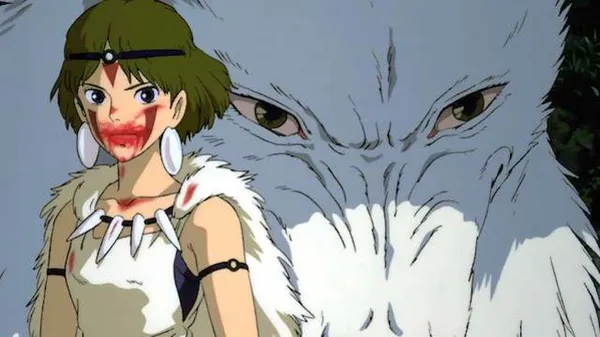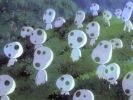Eye For Film >> Movies >> Princess Mononoke (1997) Film Review

Master animator Hayao Miyazaki may have long been admired in his native Japan, but it was only with his seventh directorial feature, Princess Mononoke, that an English-speaking mainstream started to take notice of his genius. Why was this, rather than any of his earlier films, the first to be released in the West?
It cannot be just its grandeur, for it is no more epic in scale or length than, say, his Nausicaa Of The Valley Of The Winds (1984), or Laputa: Castle In The Sky (1986). It cannot be its high degree of visual beauty, for that characterises everything to which the director sets his hand. And it cannot be its concern with pacifism, or the environment, for these themes are to be found in almost all of his works.

What distinguishes Princess Mononoke from Miyazaki's other films is that its adolescent protagonist is, despite the title, male rather than female, and it is more graphically violent than anything he has made before, or since. Of course, none of this detracts from the film's imaginative complexity, but as the nearest that Miyazaki has come to making a Boy's Own Adventure, in 1997 Princess Mononoke was well placed to match the expectations of a Western audience, whose previous experience of feature-length Japanese anime had probably been confined to Katsuhiro Otomo's Akira (1988), or just possibly Mamoru Oshii's Ghost In The Shell (1995). American and English audiences had no idea that Japan had its own equivalent to Walt Disney - and while Princess Mononoke, with its deer-led forest under threat from the encroachment of man, certainly rips off Disney's classic Bambi, it also has enough stomping Godzilla-style devastation in it to keep any cartoon fanboy happy.
In ancient times, gods and demons still walk the earth. Young Prince Ashitaka is forced to fight a demonic boar that is attacking his village in a murderous rage and sustains a supernatural injury to his arm before he can kill the beast. Hoping to lift the curse, Ashitaka sets off westwards atop his red elk, on a quest to find the source of an iron bullet that was lodged deep within the boar's body.
Soon his journey brings him to Irontown, a mountainside mining fortress which, under the leadership of Lady Eboshi, is stripping the neighbouring forest in its endless search for ore to smelt and sell. Ranged against this precarious community are samurai marauders intent on stealing the ironworks for themselves, and the wild denizens of the shrinking forest - divine wolves, tree-planting apes, an army of vengeance-seeking boars and the fearless human San Mononoke, raised by the wolves since she was a baby. Most awesome of all is the shape-shifting Spirit of the Forest, whose powers over life and death have even attracted the interest of the Emperor himself. Lady Eboshi has - or seems to have - on her side Jigo, a cynical monk with a private army of hunters, but what really gives her the edge is a new technology that is tipping the balance between humans, beasts, gods and demons - the rifle. Ever the peacemaker, Ashitaka tries to prevent all sides from unleashing an apocalypse of cosmic proportions.
While Miyazaki's ecological concerns are never in doubt, he neither oversentimentalises the forces of nature, nor demonises the human characters. The boars may be blindly aggressive, but no more so than the Imperial samurai. The divine wolf Moro may be ferocious and homicidal, but she is also maternal, noble and pious. Lady Eboshi is a destroyer of the environment and an unholy killer of gods, but at the same time she always has the best interests of her community at heart - a community that has welcomed lepers and ex-courtesans mistreated by everyone else. Even the dangerously selfish Jigo is too comic ever to become a true monster, while the film's actual demons are figures of pity as much as terror.
All these conflicts and contradictions are embodied in the Spirit of the Forest, a mighty deer with a human face whose messianic powers of creation are linked to a capacity for terrifying destruction. Only Ashitaka and Mononoke seem to have found an accommodation between the animal and human worlds, each enjoying a symbiotic relationship with their respective steeds (an elk and a wolf); but even these two characters end up having respectfully to agree to disagree on their opposed ideologies, with Mononoke continuing in her fight against the ascendancy of her own species and Ashitaka hoping to build a new, more utopian Irontown for humanity.
In this way, Miyazaki avoids any simplistic "message", preferring to present a more complicated dialectic on the environmental difficulties that continue to "curse" us to this day. He is just as equivocal in his treatment of guns, which, though at the root of Irontown's problems, also allow the townspeople to defend themselves against their many invaders. This ambivalent attitude towards weaponry seems informed, at least in part, by a curious piece of the director's own biography. The man who designed the bullets used in Japan's WWII Zero fighter planes was Miyazaki's own father. In the film, bullets certainly do great harm, but it is rage, both human and bestial, that is the real killer.
Princess Mononoke is a film full of extraordinary spectacle, but its most memorable scenes are not its epic battles, but its tableaux involving the Spirit of the Forest and the "Kodama", strange childlike tree-deities that click in unison at the advent of their Lord. These are sequences of indescribable mystery and awe, astonishing, odd and unnerving, that convey, more than anything else, what is really at stake in the film - the numinous beauty of the forest that risks being lost forever before the advances of mankind.
Its ending may be too ambiguous to be called happy, with Ashitaki forever exiled from his own idyllic home in the east, and with the age of iron and guns set to continue, but one only needs to rewatch My Neighbour Totoro, made by Miyazaki nine years earlier, to be comforted that it is still possible, even in our own times of savage war and extreme environmental degradation, for individual humans to live in harmony with the woodland spirits, in their own reimagined version of the Golden Age.
Reviewed on: 25 May 2006



















